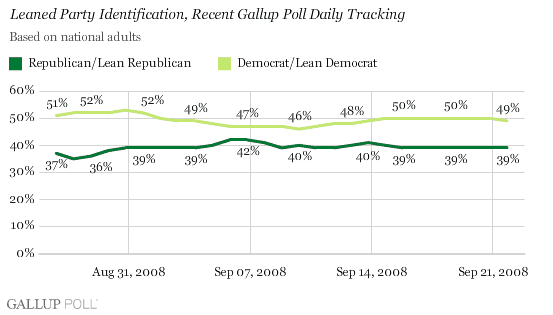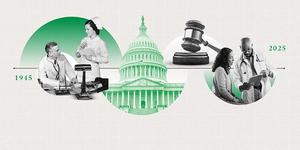PRINCETON, NJ -- Democrats have re-established a double-digit advantage over Republicans in party affiliation, with 49% of Americans identifying themselves as Democrats or leaning to the Democratic Party, and 39% identifying as Republicans or leaning to the Republican Party. This is a shift from immediately after the Republican National Convention, when Democrats enjoyed their smallest advantage of the year, leading only 47% to 42%.

For 2008 to date (based on more than 250,000 Gallup Poll Daily tracking interviews), an average of 50% of Americans have identified themselves as Democrats or have initially identified as independents but said they leaned to the Democratic Party, while 37% have aligned themselves with the Republican Party, a 13-point average advantage for the Democrats. So, with roughly half the country supporting it, 2008 has clearly been a favorable political year for the Democratic Party.
Republicans cut into that advantage in the wake of their party's convention, reducing their partisan deficit to single digits from Sept. 3-5 polling through Sept. 12-14 polling, when the averages were 47% Democratic and 40% Republican (according to the more than 9,000 interviews conducted during that time period). But in the last week, with the Wall Street financial crisis dominating the news, Democrats have regained a double-digit advantage. It is unclear whether the recent movement in partisanship reflects public reaction to the crisis, or perhaps just a return to a more normal state as the effects of the Republican convention fade.
During this past week, Democratic presidential nominee Barack Obama has also re-established an advantage over Republican John McCain in Gallup's presidential election trial heat. Obama had led by a slight margin most of the summer after clinching the Democratic nomination, but McCain emerged from the Republican convention with the lead and continued to have at least a slim advantage as recently as Sept. 13-15 polling.
The Democratic advantage in party affiliation is slightly smaller when the partisan leaners from each party group are excluded. In the Sept. 20-22 tracking data, 35% of Americans identify as Democrats, 26% Republicans, and 33% as independents, resulting in a 9-point Democratic advantage.
For the year, an average of 34% of Americans have identified as Democrats and 26% as Republicans, for an 8-point average Democratic lead.
Implications
Any momentum the Republican Party had coming out of its convention has been halted in the past week, and the Democrats have essentially re-established their dominant political positioning.
Even so, the presidential election remains close, in part because McCain has been able to command greater party loyalty than Obama. In the past week, 89% of Republican supporters said they would vote for McCain, compared with 86% of Democratic supporters favoring Obama. Additionally, the Democratic advantage in party affiliation is not as large among registered voters (51% to 42%) as it is in the total adult population (49% to 39%).
While the Democratic Party certainly is in a more advantageous position than the Republican Party to win the election, the Democrats' ability to do so will depend on their maintaining an advantage in party support over Republicans between now and Election Day, and on ensuring that their supporters remain mostly loyal to Obama and turn out to vote on Nov. 4. So far, the lesser Democratic voting loyalty to their nominee has not hurt the party because of the significant Democratic advantage in partisanship. To the extent the partisanship gap narrows (as it did the week after the Republican convention), Democratic loyalty and turnout will become more critical.
Survey Methods
Results are based on telephone interviews with 3,042 national adults, aged 18 and older, conducted Sept. 20-22, 2008, as part of Gallup Poll Daily tracking. For results based on the total sample of national adults, one can say with 95% confidence that the maximum margin of sampling error is ±2 percentage points.
Interviews are conducted with respondents on land-line telephones (for respondents with a land-line telephone) and cellular phones (for respondents who are cell-phone only).
In addition to sampling error, question wording and practical difficulties in conducting surveys can introduce error or bias into the findings of public opinion polls.
To provide feedback or suggestions about how to improve Gallup.com, please e-mail feedback@gallup.com.
